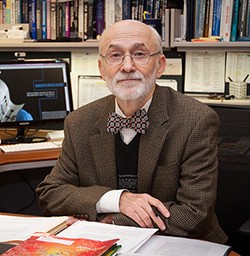
UC Professor "Papers" the Future
The February issue of "IEEE Spectrum" magazine features an article by one of the University of Cincinnati's top researchers, Andrew Steckl, an authority on advanced technologies centered on paper. The astounding uses for what is clearly a material that most of us take for granted are described in the article, titled "Circuits On Cellulose Paper Electronics Could Pave The Way To A New Generation Of Cheap, Flexible Gadgets." The online version is available at the
.
This overview of research resulting from not only his own work but that of his many colleagues around the world offers insight into a myriad of potential unexpected products made on or from paper that promise to be less expensive and easier to use than those currently made using more sophisticated (and expensive) technology. Since starting this article two years ago, it has gone through more than a dozen revisions to accommodate the many advances being made in the field around the world, states Steckl.
Cellulose is a natural material that in the various forms of paper has been around for ages and, as our technology develops further, is demonstrating even more uses. The most remarkable of which may be as a substitute for silicon in electronic substrates particularly for electronic displays. And the best part is that cellulose is readily available, renewable, biodegradable, and also combustible. Electronics built on paper can be landfilled or just compressed and burned as fuel in a power plant.

Steckl & student
Cellulose makes up about one-third of all organic biomass and when layered and wetted using a technology known as electro-microfluidics will produce electronic switches and gates much like those on a silicon-based circuit board. Among the advantages of a paper based electronic array are displays with that look and feel like real paper and can be folded or rolled, are easily carried and then discarded.
Circuits On Cellulose Paper Electronics Could Pave The Way To A New Generation Of Cheap, Flexible Gadgets in the February issue of IEEE Spectrum provides just an overview of upcoming developments and commercial possibilities. Developments underway using cellulose are interesting and surprising in their variety, comments Steckl. The number of uses is proving extraordinary.
Nanotechnology using paper mediums may be the first commercial products to reach consumers as advances in biomedical science produce diagnostic tools placed on paper that when put in contact with saliva, urine, blood or sweat will immediately tell if a person has a virus, had bad food, major disease or a hangover. Best part the cost is only a few cents and when the test is done, just burn the strip. These items could become a staple for doctors offices, third world clinics and individuals for direct use.
This abundant and simple material offers many advantages and generally low cost for the electronics of the future.
Story web location is http://spectrum.ieee.org/semiconductors/materials/electronics-on-paper
Related Stories
Mayor Pureval, Rob Richardson lead ethical AI symposium
July 5, 2024
As artificial intelligence rapidly integrates into everyday life, Rob Richardson, CEO and founder of Disrupt Now and MidwestCon and local tech startup partner of the University of Cincinnati 1819 Innovation Hub, recently spearheaded the Responsible AI Symposium with Cincinnati Mayor Aftab Pureval, calling upon community leaders to discuss and ensure artificial intelligence technologies help users rather than harm.
UC’s microchip training includes innovative VR
July 2, 2024
To build a virtual microchip factory, University of Cincinnati doctoral students turned to the real one where they work. UC launched a new training program for microchip manufacturing in advance of the new fabrication plant Intel Corp. is opening in Ohio.
UC grad’s innovative tech to manage ER wait times
June 25, 2024
When launching Teravus, a health care triage management startup, Jason Murray turned to the University of Cincinnati's Center for Entrepreneurship and the 1819 Venture Lab for guidance and funding.
